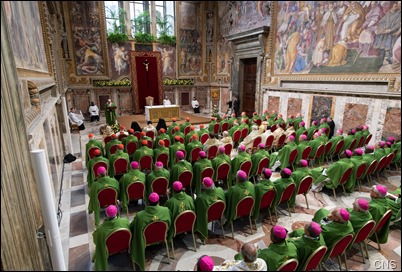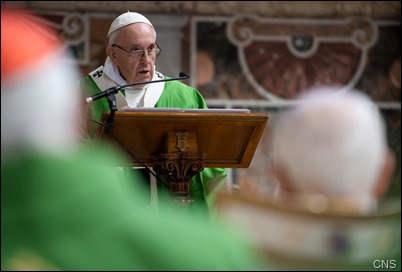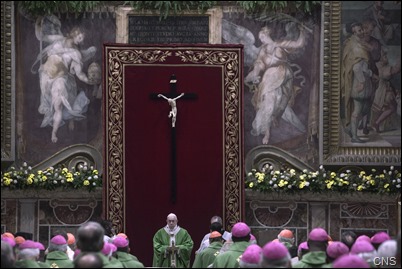Hello and welcome,
As I concluded last week, we were in the midst of the Vatican’s Meeting on the Protection of Minors in the Church. This week, I would like to share my experiences of the remainder of the conference as well as offer some thoughts on the gathering as a whole.

As I mentioned in my last post, over the course of the three-day meeting we heard from a number of different speakers and heard witness talks by abuse survivors that represented the universality of both the Church and of the challenge of child protection. In so many parts of the world, the issue of clergy sexual abuse is dismissed as an American or Western phenomenon. So, the conference was designed particularly to underscore the universal nature of the problem and to demonstrate to bishops all over the world that the leadership in the Church must own the problem and commit to making safeguarding their priority.
The witness talks by the victims and survivors were very, very powerful and represented people from many different countries. The addresses at the summit were also quite powerful, as well. A number of the talks were given by women and people from the global South, which I think was a very intentional effort to try to dispel a lot of the myths about safeguarding not being a crucial issue everywhere in the Church.
As I said, all the talks were excellent, but I was particularly moved by the address of Valentina Alazraki, a veteran Vatican journalist from Mexico, who gave a very compelling presentation on the role of the media and what the Church’s relationship with the media needs to be.
A very powerful witness was also given by Sister Veronica Openibo from Nigeria.
Of course, Saturday evening there was a penitential service that was held in the Sala Regia, which is the hall just outside the Sistine Chapel. It was a very historic setting for this important event. There, we heard an address by Archbishop Philip Naameh of Tamale, Ghana.
The following day, at the closing Mass, the preacher was Archbishop Mark Coleridge of Brisbane, Australia.
Then, we concluded with the address by the Holy Father to the bishops, in which he underscored dimensions of the problem of sexual abuse of minors both inside and outside the Church.

He ended his speech with these reflections, which included eight points of action:
The time has come, then, to work together to eradicate this evil from the body of our humanity by adopting every necessary measure already in force on the international level and ecclesial levels. The time has come to find a correct equilibrium of all values in play and to provide uniform directives for the Church, avoiding the two extremes of a “justicialism” provoked by guilt for past errors and media pressure, and a defensiveness that fails to confront the causes and effects of these grave crimes.
In this context, I would mention the “best practices” formulated under the guidance of the World Health Organization[14] by a group of ten international bodies that developed and approved a packet of measures called INSPIRE: Seven Strategies for Ending Violence against Children.
With the help of these guidelines, the work carried out in recent years by the Pontifical Commission for the Protection of Minors and the contributions made by this Meeting, the Church, in developing her legislation, will concentrate on the following aspects:
1. The protection of children. The primary goal of every measure must be to protect the little ones and prevent them from falling victim to any form of psychological and physical abuse. Consequently, a change of mentality is needed to combat a defensive and reactive approach to protecting the institution and to pursue, wholeheartedly and decisively, the good of the community by giving priority to the victims of abuse in every sense. We must keep ever before us the innocent faces of the little ones, remembering the words of the Master: “Whoever causes one of these little ones who believe in me to sin, it would be better for him to have a great millstone fastened around his neck and to be drowned in the depth of the sea. Woe to the world because of scandals! For it is necessary that scandals come, but woe to the man by whom the scandal comes! (Mt 18:6-7).
2. Impeccable seriousness. Here I would reaffirm that “the Church will spare no effort to do all that is necessary to bring to justice whosoever has committed such crimes. The Church will never seek to hush up or not take seriously any case” (Address to the Roman Curia, 21 December 2018). She is convinced that “the sins and crimes of consecrated persons are further tainted by infidelity and shame; they disfigure the countenance of the Church and undermine her credibility. The Church herself, with her faithful children, is also a victim of these acts of infidelity and these real sins of “peculation” (ibid.).

3. Genuine purification. Notwithstanding the measures already taken and the progress made in the area of preventing abuse, there is need for a constantly renewed commitment to the holiness of pastors, whose conformity to Christ the Good Shepherd is a right of the People of God. The Church thus restates “her firm resolve to pursue unstintingly a path of purification, questioning how best to protect children, to avoid these tragedies, to bring healing and restoration to the victims, and to improve the training imparted in seminaries… An effort will be made to make past mistakes opportunities for eliminating this scourge, not only from the body of the Church but also from that of society” (ibid.). The holy fear of God leads us to accuse ourselves – as individuals and as an institution – and to make up for our failures. Self-accusation is the beginning of wisdom and bound to the holy fear of God: learning how to accuse ourselves, as individuals, as institutions, as a society. For we must not fall into the trap of blaming others, which is a step towards the “alibi” that separates us from reality.
4. Formation. In other words, requiring criteria for the selection and training of candidates to the priesthood that are not simply negative, concerned above all with excluding problematic personalities, but also positive, providing a balanced process of formation for suitable candidates, fostering holiness and the virtue of chastity. Saint Paul VI, in his encyclical Sacerdotalis Caelibatus, wrote that “the life of the celibate priest, which engages the whole man so totally and so sensitively, excludes those of insufficient physical, psychic and moral qualifications. Nor should anyone pretend that grace supplies for the defects of nature in such a man” (No. 64).
5. Strengthening and reviewing guidelines by Episcopal Conferences. In other words, reaffirming the need for bishops to be united in the application of parameters that serve as rules and not simply indications. Rules, not simply indications. No abuse should ever be covered up (as was often the case in the past) or not taken sufficiently seriously, since the covering up of abuses favours the spread of evil and adds a further level of scandal. Also and in particular, developing new and effective approaches for prevention in all institutions and in every sphere of ecclesial activity.
6. Accompaniment of those who have been abused. The evil that they have experienced leaves them with indelible wounds that also manifest themselves in resentment and a tendency to self-destruction. The Church thus has the duty to provide them with all the support they need, by availing herself of experts in this field. Listening, let me even put it this way: “wasting time” in listening. Listening heals the hurting person, and likewise heals us of our egoism, aloofness and lack of concern, of the attitude shown by the priest and the Levite in the parable of the Good Samaritan.

7. The digital world. The protection of minors must take into account the new forms of sexual abuse and abuse of all kinds that threaten minors in the settings in which they live and through the new devices that they use. Seminarians, priests, men and women religious, pastoral agents, indeed everyone, must be aware that the digital world and the use of its devices often has a deeper effect than we may think. Here there is a need to encourage countries and authorities to apply every measure needed to contain those websites that threaten human dignity, the dignity of women and particularly that of children. Brothers and Sisters: crime does not enjoy the right to freedom. There is an absolute need to combat these abominations with utter determination, to be vigilant and to make every effort to keep the development of young people from being troubled or disrupted by an uncontrolled access to pornography, which will leave deep scars on their minds and hearts. We must ensure that young men and women, particularly seminarians and clergy, are not enslaved to addictions based on the exploitation and criminal abuse of the innocent and their pictures, and contempt for the dignity of women and of the human person. Here mention should be made of the new norms on graviora delicta approved by Pope Benedict XVI in 2010, which included as a new species of crime “the acquisition, possession or distribution by a cleric of pornographic images of minors… by whatever means or using whatever technology”. The text speaks of minors “under the age of fourteen”. We now consider that this age limit should be raised in order to expand the protection of minors and to bring out the gravity of these deeds.
8. Sexual tourism. The conduct, the way of looking at others, the very heart of Jesus’ disciples and servants must always acknowledge the image of God in each human creature, beginning with the most innocent. It is only by drawing from this radical respect for the dignity of others that we will be able to defend them from the pervasive power of violence, exploitation, abuse and corruption, and serve them in a credible way in their integral human and spiritual growth, in the encounter with others and with God. Combatting sexual tourism demands that it be outlawed, but also that the victims of this criminal phenomenon be given support and helped to be reinserted in society. The ecclesial communities are called to strengthen their pastoral care of persons exploited by sexual tourism. Among these, those who are most vulnerable and in need of particular help are certainly women, minors and children; these last however need special forms of protection and attention. Government authorities should make this a priority and act with urgency to combat the trafficking and economic exploitation of children. To this end it is important to coordinate the efforts being made at every level of society and to cooperate closely with international organizations so as to achieve a juridical framework capable of protecting children from sexual exploitation in tourism and of ensuring the legal prosecution of offenders.
For many of the bishops, I think the conference was a very transformative experience. For many of them, it was the first time that they were listening to victim/survivors; it was the first time they were hearing about the challenges of safeguarding and the responsibility of the bishops.
When you think of the fact that there were 200 bishops there representing over 180 bishops’ conferences, plus several different bishops or patriarchs in charge of different Eastern Rites of the Catholic Church, you realize this was the leadership of over 1 billion Catholics in the world coming together to reflect and pray about this issue, which in countries like the United States we have grappled with for years. However, for many bishops, it was the first time that they were being exposed in a serious way to this issue.
I was very edified by the spirit among the bishops who realized that this is something the whole Church must work to address to ensure the safety of children. We may not have resolved all the issues that we face in the United States around the accountability of bishops and so forth, but for the Universal Church I think it was a huge step forward.
Obviously, we are looking for concrete measures to come out of this meeting. We know that Archbishop Scicluna has said that there is going to be a vademecum published by the Congregation of the Doctrine of the Faith to help people to know, every step of the way, what the response needs to be in individual dioceses.
We will also be meeting with the Pontifical Commission for the Protection of Minors to continue our work on an auditing process, so that we will be able to offer to the Church an instrument that will allow for an independent evaluation of the implementation of child protection policies in each bishops’ conference. We envision that will be part of the ad limina reports — that when each diocese must report on the situation in their diocese, a very thorough report will be given on how their safeguarding protocols are being implemented.
Of course, the talk by Cardinal Cupich outlined once again a program for reporting of the malfeasance of bishops. Discussion of this was begun at the U.S. Conference of Catholic Bishops’ meeting in November and will be the major topic of the upcoming meeting in June.
Finally, I want to mention that once again this year at Ash Wednesday services throughout the archdiocese, there will be a special collection benefitting Catholic Charities. Proceeds from this Special Collection will support their critically important work helping local vulnerable families and individuals on their journey toward sustained self-sufficiency.

Last year, Catholic Charities distributed nearly 4 million pounds of food to more than 100,000 individuals, provided 6,500 nights of secure housing to women and children, and provided critical support services to more than 20,000 immigrants and refugees. Please join me in supporting their important mission on Ash Wednesday, March 6.
Until next week,
Cardinal Seán
